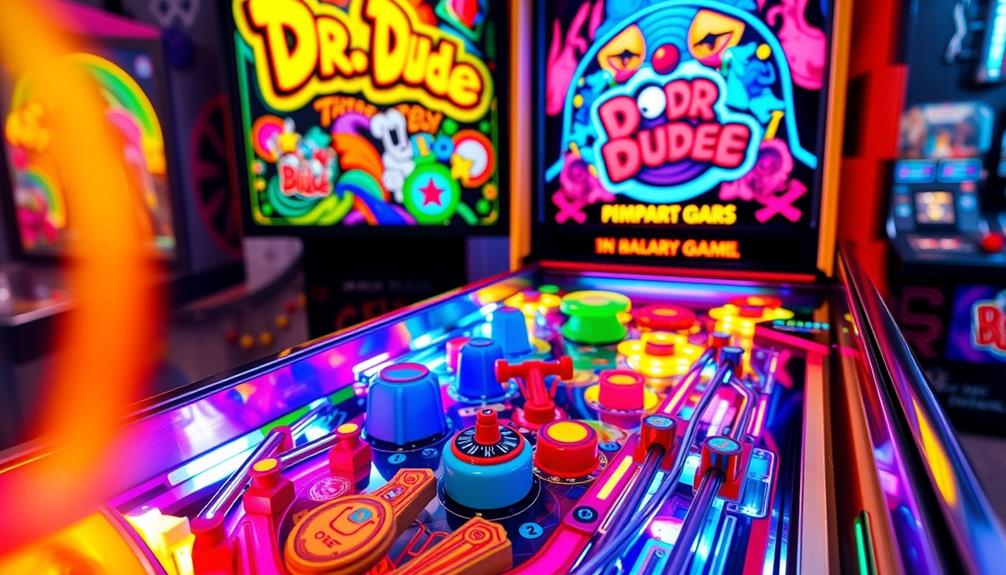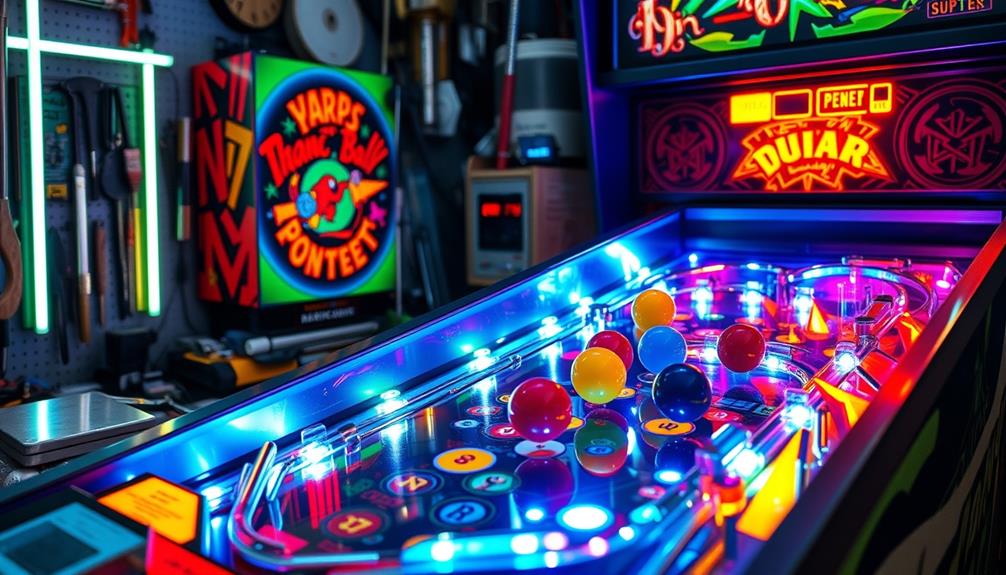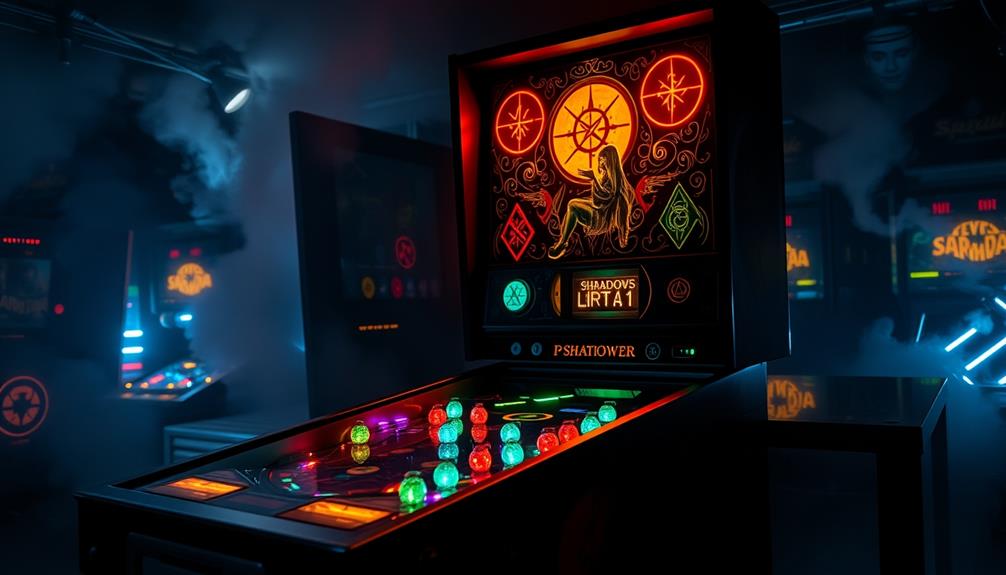Dr. Dude pinball delivers thrilling gameplay with a unique twist that keeps you engaged and entertained. You'll aim to raise the Dude-O-Meter, showcasing your coolness while maneuvering the Molecular Mixmaster for those coveted Elements of Coolness. The game features exciting multiball opportunities, where you can rack up to 5 million points. Master ball control techniques and scoring strategies to maximize your scores, ensuring every shot counts. With a vibrant community and a booming market, there's always something happening. Stick around, and you'll uncover even more about this iconic game and the adventures it brings!
Key Takeaways
- Dr. Dude features the Molecular Mixmaster, collecting Elements of Coolness to enhance scoring and gameplay dynamics.
- The Dude-O-Meter tracks progress, providing a unique measure of coolness that carries over between games.
- A thrilling 2-ball multiball feature offers jackpot potential of up to 5 million points, elevating excitement during play.
- Effective ball control techniques, such as live catches and nudging, are crucial for maximizing scoring opportunities.
- Engaging customization options, including protective measures and aesthetic upgrades, enhance the overall pinball experience.
Game Overview

In Dr. Dude and His Excellent Ray, you plunge into a vibrant world of pinball excitement that captures the essence of coolness. Released by Bally in 1990, this game designed by Dennis Nordman features eye-catching art by Greg Freres, making it visually striking. Your main goal is to raise the Dude-O-Meter, proving your coolness as you engage with the unique gameplay elements.
The game introduces the Molecular Mixmaster mechanism, allowing you to collect Elements of Coolness, which activate thrilling rewards during play. You'll find yourself immersed in themes like Rock N Roll and Magnetic Personality, adding depth to your experience.
The gameplay is further enhanced by a 2-ball multiball feature, offering a jackpot potential of up to 5 million points. It's an adrenaline rush as you aim for those high scores, pushing your skills to the limit.
Dr. Dude's engaging storyline and dynamic visuals have cemented its place in the pinball community. Whether you're a seasoned player or new to the scene, this game promises fun with a cool twist, inviting you to explore its exciting world.
Get ready for a pinball adventure like no other!
Unique Gameplay Features

Players will discover a range of unique gameplay features in Dr. Dude that set it apart from typical pinball experiences. One standout element is the Molecular Mixmaster, which activates the Excellent Ray. This feature allows you to combine collected Elements of Coolness for fantastic rewards and multiball opportunities.
Additionally, the game incorporates elements of strategy that can be found in the best arcade machines for home game rooms, making every playthrough exciting and dynamic.
In Dr. Dude, you can also experience the thrill of a 2-ball multiball, creating chances to rack up extra points, especially by hitting targets for a Gazillion Jackpot worth between 1 million and 5 million points.
Here are a few more unique aspects to look out for:
- Dude-O-Meter: Tracks your progress and carries over between games, adding a competitive edge.
- Combo Shots: The gameplay encourages skillful timing and precision, rewarding those who master their shots.
- Skill Shot: Hitting the I Exam at the right moment can maximize your scoring potential.
With these features, Dr. Dude isn't just about flipping flippers; it's about strategy, timing, and making the most of each unique gameplay element. Get ready to plunge into the fun!
Scoring Strategies

Mastering scoring strategies in Dr. Dude can elevate your gameplay to new heights.
First, focus on the Gazillion shot. Each target hit rewards you with 500,000 points, so timing your shots is essential. Aim for this shot consistently to rack up points quickly.
Next, implement an effective multiball strategy. Lock one ball in the Ray while using the second ball to target drop targets. Clearing these during the multiball phase doubles your points, which can lead to significant score increases.
After multiball ends, activate the 2x playfield scoring to maximize your point potential even further.
Don't forget about the Mixmaster! This feature is important for consistent scoring. Shooting for the Mixmaster allows you to achieve jackpots, and aiming for ten hits on tri-clusters prepares you for an explosive multiball experience.
Ball Control Techniques

Controlling the ball effectively can make all the difference in Dr. Dude. Mastering ball control techniques not only enhances your gameplay but also maximizes your scoring potential. Here are a few key strategies to help you gain the upper hand:
- Pre-emptive nudging: Use this technique against the central post of the Mixmaster to keep the ball stable and minimize unwanted drains.
- Catch techniques: Practice live catches and drop catches to improve your overall ball control and make more precise shots during critical moments.
- Separation during multiball: Keep the balls apart on the flippers to create better scoring opportunities, allowing you to execute skill shots effectively.
During gameplay, remember to let the ball settle naturally inside the Mixmaster. Nudge attempts can lead to quicker exits, so patience pays off.
Utilize the right flipper for Mixmaster and Ray shots, as it's more reliable. Also, consider using dead passes and nudge passes to manage the flow of the game.
Risk Management Tips

While refining your ball control techniques sets a solid foundation, managing risks effectively can elevate your gameplay in Dr. Dude. Start by avoiding shots at drop targets or Reflect shots; these can lead to unnecessary drain risks that disrupt your rhythm.
Understanding the mechanics of pinball machines is vital, as it allows you to better anticipate how the ball will interact with various components. Before you take a shot, assess potential drain risks, especially when you're targeting the Mixmaster. This guarantees you maintain ball control and don't end up losing your hard-earned progress.
When the ball approaches the flipper, give it a nudge upward. This simple maneuver increases your chances of catching the ball and helps prevent those pesky drains caused by slingshots.
After every shot, closely monitor the ball's behavior. Anticipating how it will react can make all the difference in staying in control of the game.
Lastly, make strategic decisions regarding when to go for Elements of Coolness. Timing is critical; if you shoot too soon or too late, you might face higher drain risks.
Community Insights

There's something special about being part of the Digital Pinball Fans community, where players unite to share their love for Dr. Dude. Since its establishment in 2012, this vibrant community has become a hub for exchanging valuable tips, strategies, and experiences.
You'll find discussions buzzing with excitement about everything from high scores to the unique gameplay mechanics that make Dr. Dude a favorite.
Here are some highlights of what you can expect in this engaging community:
- Shared Strategies: Members exchange game techniques that can help you improve your ball control and ultimately boost your high scores.
- Nostalgic Moments: Players often post requests for memorable sound effects and gameplay recordings that deepen the nostalgia surrounding Dr. Dude.
- Celebrating Achievements: Whether you've reached grand champion status or just hit a new high score, the community celebrates every achievement, complete with light shows and cheers.
As you connect with fellow enthusiasts, you'll discover various opinions on gameplay challenges, ensuring that everyone finds their place in this thriving community.
Join in and experience the joy of playing together!
Market Value Analysis

In recent years, the market for Dr. Dude pinball machines has seen a notable surge in value. This resurgence can be attributed to its popularity as one of the best rated pinball machines of 2024, as enthusiasts seek out high-quality experiences that blend nostalgia with modern features.
You'll find that average selling prices now range from $1,200 to $1,500 for units in good condition, with pristine models fetching between $2,000 and $2,200. This increase reflects a growing appreciation among collectors who recognize the game's unique charm and appeal. Just a few years ago, prices hovered around $800 to $1,200, indicating significant market growth.
The availability of parts plays a vital role in determining the overall market value of Dr. Dude machines. Collectors actively seek replacement components to maintain and restore their machines, and this demand can drive prices up. For instance, the Big Shot figure, a sought-after part, typically sells for around $150, showcasing its desirability within the community.
Active discussions in forums further highlight the vibrant culture surrounding Dr. Dude, influencing both supply and demand. As collectors connect and share insights, the market value continues to evolve, making it an exciting time to be involved in the world of pinball.
Maintenance and Modifications

When maintaining your Dr Dude pinball machine, you'll face challenges in sourcing replacement parts, especially for unique components like the Big Shot figure.
Fortunately, you can also explore a range of customization options to tailor your gameplay experience.
The active modding community provides plenty of upgrades that can enhance both the fun and functionality of your machine.
Replacement Parts Challenges
Facing challenges in sourcing replacement parts for Dr. Dude can be frustrating. Many collectors struggle to find essential components, particularly ramps that are easily damaged. The scarcity of certain parts only adds to the challenge, but you're not alone in this journey.
Here are some common hurdles you might encounter:
- Limited Availability: Key parts like the Big Shot figure are hard to come by, often selling for around $150 due to their rarity.
- Ramp Protection: Without appropriate protectors, your ramps can wear out quickly. Cliffy protectors are a must-have to safeguard these vulnerable areas and extend their lifespan.
- Costly Repairs: Tracking down replacement parts can become an expensive endeavor, especially for components that require specific modifications.
The modding community offers a wealth of options to enhance your game, but it's crucial to strike a balance between fun and the challenges of sourcing those elusive parts.
Customization Options Available
Customization options for Dr. Dude enable you to tailor the game to fit your unique play style. You can adjust various game settings to enhance your experience, making it more enjoyable and personalized.
The vibrant modding community is constantly creating upgrades, which include aesthetic changes and performance improvements to elevate your gameplay.
To protect your investment, consider adding custom protective measures like Cliffy protectors. These can help prevent ramp damage, extending the life of your machine and maintaining its value.
If you're a collector, you might want to hunt down limited reproduction parts, such as the Big Shot figure. These additions not only restore your machine but also give it a distinctive flair that sets it apart from others.
Regular maintenance and modifications, including cleaning and repairs, are essential for keeping Dr. Dude in peak condition. By staying on top of these tasks, you'll guarantee peak performance and longevity of your pinball machine.
Embrace the customization options available to you, and let your creativity shine as you enhance your gaming experience!
Event Rental Information

If you're planning an event in California or Las Vegas, you're in luck!
Video Amusement offers a range of pinball machines, including the Dr. Dude, along with other fun games to fit your theme.
Plus, their event planning assistance guarantees you'll pick the perfect games for an unforgettable experience.
Rental Service Areas
Renting from Dr. Dude means you're in for a fantastic time with Pinball Machines at your next event! Our rental service spans a wide area throughout California, making it easy for you to bring the fun wherever you are. Major cities like San Francisco, San Jose, and Santa Clara are just the beginning.
We also serve areas such as:
- Santa Cruz
- Sacramento
- Los Angeles
And if you're in Las Vegas, Nevada, or other parts of the Western United States, we've got you taken care of there too!
When you choose Dr. Dude, you're not just getting a Pinball Machine; you're enhancing your events with a unique gaming experience. Our tailored game selection guarantees your parties and gatherings are engaging and memorable.
Plus, you can always inquire about additional games available for rental, giving you even more options to entertain your guests.
With Dr. Dude, you can transform any event into an unforgettable adventure! So, get ready to enjoy some serious pinball fun!
Game Selection Options
When planning an event, selecting the right games can make all the difference in creating a lively atmosphere. With the Dr. Dude pinball machine as your centerpiece, you've already got a fantastic start. Available for rental throughout California, including major cities like San Francisco, Los Angeles, and San Diego, this game is sure to attract attention.
But why stop there? You can explore additional game selection options, like the Star Trek PRO Pinball Machine, which adds a sci-fi twist to your pinball arcade experience.
If you're looking for multiplayer fun, consider the Pac-Man Battle Royale Chompionship DX, accommodating up to 8 players for a thrilling competition.
For those special events, you can request a tailored game selection that fits your theme and audience. Plus, don't forget about the Prize Wheel for Spin and Win activities—it adds an interactive element that your guests will love.
With these exciting game options, you're all set for a memorable event that keeps everyone engaged and entertained. So, get ready to elevate your gathering with the best game selection options available!
Event Planning Assistance
Planning an event can feel overwhelming, but Video Amusement is here to help you navigate the process with ease. With their event planning assistance, you'll find the perfect games to guarantee your gathering is memorable. Imagine adding the Dr. Dude pinball machine to your lineup, bringing a vibrant, nostalgic vibe that your guests will love.
Here are a few options to take into account:
- Prize Wheel for Spin and Win: This interactive element will keep your guests engaged and excited.
- Glow LED Foosball Table: Perfect for larger gatherings, this 12-player table amps up the fun and accommodates more guests.
- Tailored Game Selection: Choose from a range of games, including classics like Rock N Roll, to create a customized experience.
Video Amusement takes the stress out of event planning, making sure you have everything you need for a successful party. From game selection to setup, they focus on delivering a fun atmosphere that meets your specific requirements.
Frequently Asked Questions
What Is the History Behind the Creation of Dr Dude?
You'll find that Dr. Dude was created in the late 1980s, blending innovative technology with vibrant themes. Designers aimed to attract players by adding unique features, making it a standout pinball machine in arcades.
Are There Any Notable Tournaments for Dr Dude Pinball?
You'll feel the electric buzz of competition as you immerse yourself in epic tournaments for Dr Dude pinball. These events ignite fierce rivalries, where players unleash their skills, battling for glory and unforgettable bragging rights!
How Does Dr Dude Compare to Other Pinball Machines From the Same Era?
You'll find that Dr Dude stands out with its unique gameplay mechanics and vibrant design, offering a different experience than other machines from the same era, which often focused more on traditional pinball layouts and themes.
What Age Group Is Dr Dude Suitable For?
You'll find that Dr Dude appeals mostly to teens and adults. Its engaging gameplay and vibrant themes attract a wide audience, but younger children might struggle with some mechanics, making it less suitable for them.
Are There Any Special Editions or Variations of Dr Dude Available?
Yes, there are special editions and variations of the game available. You'll find different themes and artwork in these versions, which can enhance your experience and keep gameplay exciting for you and your friends.
Conclusion
In the thrilling world of Dr. Dude, you're not just playing pinball; you're starting a pulsating, playful pursuit of points! With its dynamic design and dazzling features, you're bound to bounce your way to brilliance. Remember, mastering ball control and managing risks can lead to triumphant scores. So, grab your friends, ignite your competitive spirit, and plunge into this delightful domain of pinball fun, where every flip and fling fuels fantastic memories! With each electrifying spin of the spinner and every skillful nudge of the table, the excitement only grows, drawing players deeper into its mesmerizing mechanics. But as the lights dim and the intensity heightens, one question echoes through the buzz of the machine: are you afraid of the dark, or will you embrace the challenge and conquer the chaos? Step up, take the plunge, and let Dr. Dude prove that bravery and precision are the cornerstones of pinball greatness!








